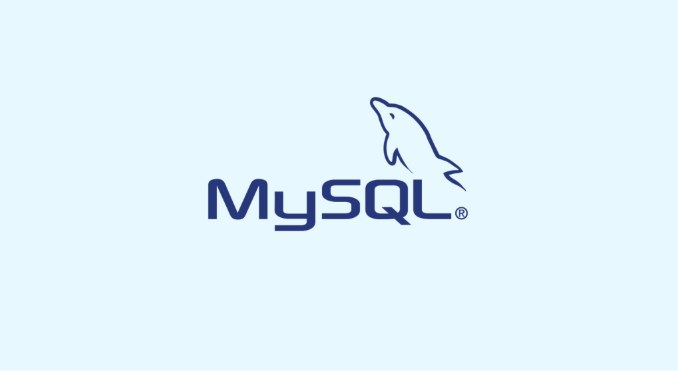Designing an efficient and scalable MySQL database structure requires starting from four aspects: data type, indexing strategy, standardization and anti-standardization and naming specifications. 1. Reasonably select the field type, such as using INT instead of BIGINT, CHAR is better than VARCHAR (fixed length), and the time field is preferred to DATETIME or TIMESTAMP to avoid abuse of TEXT/BLOB, and enumeration classes can be used for ENUM or small table foreign keys; 2. Use the index correctly, do not create indexes in low-cardinal sequences, avoid fuzzy matching failure, combine indexes follow the principle of leftmost prefix, and regularly analyze slow query logs; 3. Fight normalization and anti-standardization, appropriately redundant commonly used fields to reduce JOIN, wide tables or JSON fields can be used for scenarios that read more and write less, but data consistency risks need to be prevented; 4. Clear and unified naming, use lowercase underscores to separate, add comments and maintain documents, and improve team collaboration efficiency.

Designing an efficient and scalable MySQL database structure is the basis for building stable applications. Many performance problems and maintenance problems have actually laid the groundwork as early as when building tables. The key is to plan the relationship between field types, index policies and tables in advance.

1. Reasonably select the data type
MySQL provides a wealth of data types, but choosing the right one is the key. For example, INT is enough for integers, so there is no need to use BIGINT; if the length of a string is fixed, CHAR is more suitable than VARCHAR; the time field is preferred to DATETIME or TIMESTAMP, pay attention to the differences in their range and time zone processing.

- Try to use smaller data types: the smaller the space, the higher the read and write efficiency
- Avoid abuse of TEXT/BLOB types, which may cause additional disk I/O and memory consumption
- Enumerated class fields can be considered to use ENUM or use foreign keys to associate small tables to avoid using magic values.
2. Use index correctly
The more indexes, the better, and not all queries can hit the index. Common misconceptions include adding indexes (such as gender) to low cardinality sequences, or using wildcards at the beginning of fuzzy matches to cause index failure.
The focus is on indexing fields that are often used to query conditions, sort, and group. When querying multi-field, combined indexes are more effective than multiple single-column indexes, but pay attention to the principle of leftmost prefix.

For example, there is such a joint index (name, age, city):
- You can hit the name query
- You can hit the name age query
- Can't hit age or city query alone
Also, remember to analyze the slow query log regularly to see which fields are missing indexes and which indexes are not used.
3. The trade-off between standardization and anti-normative
In database design, the third normal can reduce data redundancy, but sometimes some anti-specifications are needed to query performance. For example, save user names in the order table instead of joining the user table every time.
Common practices include:
- Redundant some commonly used fields to reduce join operations
- For scenarios where more reads and less writes, wide tables or materialized views can be used (although MySQL native support is limited)
- Use JSON fields to store unstructured data, but control how often you use it and how you access it
However, it should also be noted that excessive anti-standardization will bring about data consistency risks and need to be judged in combination with business logic.
4. Clearly named and complete documents
Try to use underscore-separated lowercase English, such as user_profile instead of UserProfile. Unified naming style helps with post-maintenance.
Also, don't forget to add comments. You can use the COMMENT keyword to add descriptions to tables and fields. When collaborating with a team, it is best to have a document that is updated simultaneously, even if it is just a simple ER diagram.
Basically that's it. A good schema design is not necessarily complicated, but it must be thought-provoked.
The above is the detailed content of Best practices for MySQL database schema design. For more information, please follow other related articles on the PHP Chinese website!

Hot AI Tools

Undress AI Tool
Undress images for free

Undresser.AI Undress
AI-powered app for creating realistic nude photos

AI Clothes Remover
Online AI tool for removing clothes from photos.

Clothoff.io
AI clothes remover

Video Face Swap
Swap faces in any video effortlessly with our completely free AI face swap tool!

Hot Article

Hot Tools

Notepad++7.3.1
Easy-to-use and free code editor

SublimeText3 Chinese version
Chinese version, very easy to use

Zend Studio 13.0.1
Powerful PHP integrated development environment

Dreamweaver CS6
Visual web development tools

SublimeText3 Mac version
God-level code editing software (SublimeText3)

Hot Topics
 How to install MySQL 8.0 on Windows/Linux?
Jun 11, 2025 pm 03:25 PM
How to install MySQL 8.0 on Windows/Linux?
Jun 11, 2025 pm 03:25 PM
The key to installing MySQL 8.0 is to follow the steps and pay attention to common problems. It is recommended to use the MSI installation package on Windows. The steps include downloading the installation package, running the installer, selecting the installation type, setting the root password, enabling service startup, and paying attention to port conflicts or manually configuring the ZIP version; Linux (such as Ubuntu) is installed through apt, and the steps are to update the source, installing the server, running security scripts, checking service status, and modifying the root authentication method; no matter which platform, you should modify the default password, create ordinary users, set up firewalls, adjust configuration files to optimize character sets and other parameters to ensure security and normal use.
 What is the default username and password for MySQL?
Jun 13, 2025 am 12:34 AM
What is the default username and password for MySQL?
Jun 13, 2025 am 12:34 AM
The default user name of MySQL is usually 'root', but the password varies according to the installation environment; in some Linux distributions, the root account may be authenticated by auth_socket plug-in and cannot log in with the password; when installing tools such as XAMPP or WAMP under Windows, root users usually have no password or use common passwords such as root, mysql, etc.; if you forget the password, you can reset it by stopping the MySQL service, starting in --skip-grant-tables mode, updating the mysql.user table to set a new password and restarting the service; note that the MySQL8.0 version requires additional authentication plug-ins.
 How to enable SSL/TLS encryption for MySQL connections?
Jun 11, 2025 pm 03:29 PM
How to enable SSL/TLS encryption for MySQL connections?
Jun 11, 2025 pm 03:29 PM
Enable MySQL's SSL/TLS encryption connection can effectively prevent data leakage. The specific steps are as follows: 1. Confirm that the MySQL version supports SSL, and check whether the return value is YES through SHOWVARIABLESLIKE'have_ssl'; 2. Prepare a PEM format certificate file (ca.pem, server-cert.pem, server-key.pem), which can be generated through OpenSSL or obtained from CA; 3. Modify the MySQL configuration file, add ssl-ca, ssl-cert and ssl-key paths in the [mysqld] section and restart the service; 4. Force the client to use SSL, and use CREATEUSER
 What is the MySQL binary log (binlog) and what is it used for?
Jun 11, 2025 pm 03:41 PM
What is the MySQL binary log (binlog) and what is it used for?
Jun 11, 2025 pm 03:41 PM
MySQL's binary log (binlog) is a binary log that records database change operations, and is used in scenarios such as data recovery, master-slave replication and auditing. 1. Binlog is a logical log file that records all operation events that modify data, such as INSERT, UPDATE, DELETE, etc., but does not include SELECT or SHOW query statements; 2. Its main uses include: data recovery through replay logs, supporting master-slave copying to achieve data synchronization, and used to analyze operation records to meet audit requirements; 3. Enable binlog requires setting log-bin, server-id, binlog_format and expire_logs_day in the configuration file.
 How to change or reset the MySQL root user password?
Jun 13, 2025 am 12:33 AM
How to change or reset the MySQL root user password?
Jun 13, 2025 am 12:33 AM
There are three ways to modify or reset MySQLroot user password: 1. Use the ALTERUSER command to modify existing passwords, and execute the corresponding statement after logging in; 2. If you forget your password, you need to stop the service and start it in --skip-grant-tables mode before modifying; 3. The mysqladmin command can be used to modify it directly by modifying it. Each method is suitable for different scenarios and the operation sequence must not be messed up. After the modification is completed, verification must be made and permission protection must be paid attention to.
 What is GTID (Global Transaction Identifier) and what are its advantages?
Jun 19, 2025 am 01:03 AM
What is GTID (Global Transaction Identifier) and what are its advantages?
Jun 19, 2025 am 01:03 AM
GTID (Global Transaction Identifier) ??solves the complexity of replication and failover in MySQL databases by assigning a unique identity to each transaction. 1. It simplifies replication management, automatically handles log files and locations, allowing slave servers to request transactions based on the last executed GTID. 2. Ensure consistency across servers, ensure that each transaction is applied only once on each server, and avoid data inconsistency. 3. Improve troubleshooting efficiency. GTID includes server UUID and serial number, which is convenient for tracking transaction flow and accurately locate problems. These three core advantages make MySQL replication more robust and easy to manage, significantly improving system reliability and data integrity.
 What is a typical process for MySQL master failover?
Jun 19, 2025 am 01:06 AM
What is a typical process for MySQL master failover?
Jun 19, 2025 am 01:06 AM
MySQL main library failover mainly includes four steps. 1. Fault detection: Regularly check the main library process, connection status and simple query to determine whether it is downtime, set up a retry mechanism to avoid misjudgment, and can use tools such as MHA, Orchestrator or Keepalived to assist in detection; 2. Select the new main library: select the most suitable slave library to replace it according to the data synchronization progress (Seconds_Behind_Master), binlog data integrity, network delay and load conditions, and perform data compensation or manual intervention if necessary; 3. Switch topology: Point other slave libraries to the new master library, execute RESETMASTER or enable GTID, update the VIP, DNS or proxy configuration to
 How to connect to a MySQL database using the command line?
Jun 19, 2025 am 01:05 AM
How to connect to a MySQL database using the command line?
Jun 19, 2025 am 01:05 AM
The steps to connect to the MySQL database are as follows: 1. Use the basic command format mysql-u username-p-h host address to connect, enter the username and password to log in; 2. If you need to directly enter the specified database, you can add the database name after the command, such as mysql-uroot-pmyproject; 3. If the port is not the default 3306, you need to add the -P parameter to specify the port number, such as mysql-uroot-p-h192.168.1.100-P3307; In addition, if you encounter a password error, you can re-enter it. If the connection fails, check the network, firewall or permission settings. If the client is missing, you can install mysql-client on Linux through the package manager. Master these commands






